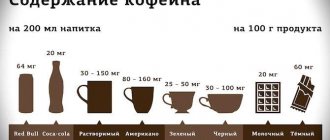Caffeine
Most people think of caffeine as brown flecks similar to instant coffee. In reality, they are colorless or whitish crystals that have a bitter taste. Caffeine is a purine alkaloid or a complex chemical compound of organic origin containing nitrogen. This substance is extracted from coffee and tea plants, and caffeine in its pure form is obtained from waste.
Where is caffeine found?
Caffeine is the most common substance in the world. It is especially popular as stimulating drinks - coffee, tea and a variety of energy drinks. Caffeine is present not only in coffee, but also in tablets of the same name, many foods, drinks and medicines.
So, here is the caffeine content data:
- Brewed coffee (95-125 mg per cup).
- Instant coffee (60-70 mg per cup).
- Black tea (30-70 mg per mug).
- Green tea (25-50 mg per mug).
- Pepsi and Coca-Cola (30-45 mg per 100 g).
- Cocoa (10-18 mg per glass).
- Bittersweet (60 mg per 100 g) and some types of milk chocolate (20 mg per 100 g).
- Energy drinks (30-80 mg per 250 ml).
- Contained in cola nuts and guarana fruits.
- Found in some medications.
It is worth considering that the amount of caffeine depends on the type and method of preparing coffee and tea.
Caffeine: how much and where?
The problem of energy drink consumption is a constant topic in the media and in the medical community. A number of food industry specialists, doctors and commodity producers turned to the National Consumer Protection Fund with a request to look into this problem at an independent expert level.
Tea and coffee are the main sources of caffeine
The National Fund for the Support of Manufacturers decided to create a working group to implement the expert-analytical project “Analysis of the risks of consuming caffeine-containing food products presented on the Russian consumer market.”
The products were tested by authoritative specialists from VTsIOM and the Research Institute of Nutrition of the Russian Academy of Medical Sciences. Among other things, samples of non-alcoholic tonic drinks from the most famous brands were analyzed and evaluated.
Today, the caffeine content in so-called “energy” drinks is most strictly regulated and controlled, experts say. At the same time, other segments of caffeine-containing drinks are not regulated or standardized by the state to the proper extent. However, expertise suggests that the main sources of caffeine in food products are tea and coffee.
According to scientists from the Research Institute of Nutrition of the Russian Academy of Medical Sciences, caffeine contained in food products, drinks and medicines should be considered as a source of risks that must be assessed and taken into account.
During the study, various methods were used, including analytical chemistry (high-performance liquid chromatography), computational and statistical methods of analysis. Please note that the study was conducted using data available as of November 2013.
Where is there more caffeine?
The selection of product samples was carried out by a commission of the fund with the involvement of specialists from interested parties. The collected samples were delivered to the accredited laboratory of the Research Institute of Nutrition of the Russian Academy of Medical Sciences, where they were handed over to authorized persons for examination under an agreement with the foundation.
In accordance with the results obtained, the highest caffeine content of all the presented types of food products was found in coffee samples. Depending on the type and manufacturer, the spread of the data obtained ranged from 272 mg/l, that is, slightly more than in some types of tea, to 3105 mg/l.
Thus, latte coffee can contain 272-398 mg/kg of caffeine, and black tea can contain 244-301 mg/kg. But at the same time: Such a “heavyweight” as espresso can contain 1295-3105 mg/kg, and mate tea – only 92 mg/kg.
In general, the caffeine content in the tea samples ranged from 58 mg/L to 301 mg/L. In cocoa and hot chocolate from 37 mg/l. up to 397 mg/l.
The level of caffeine in chocolate depended on its type, milk content and other components. The amount of caffeine ranged from 103 mg/kg in milk chocolate with whole hazelnuts to 665 mg/kg in dark chocolate. You need to understand that the caffeine content in the same dark chocolate, but from different manufacturers, may vary.
Energy drinks contained the least amount of caffeine in the results. The highest caffeine content in energy drinks is 321 mg/l, and the lowest is 218.6 mg/l.
The caffeine content of the most popular carbonated soft drinks ranged from 87 mg/L to 130 mg/L.
Experts: safe level has definitely been exceeded
In parallel with determining the caffeine content in various caffeine-containing food products, at the request of the National Fund for Consumer Protection, VTsIOM conducted a survey of consumers in 131 localities in 46 constituent entities of the Russian Federation, in order to study the structure, levels and sources of caffeine consumption in the diet of certain categories of the population of the Russian Federation.
The survey involved 3,600 consumers, including 1,600 adult respondents aged 18-44 years and 2,000 teenage respondents aged 12-17 years.
As expected, tea became the most consumed caffeine-containing product among Russians. This drink is consumed by 95% of adults and 98% of adolescents aged 12-17 years. The lowest share of consumers (both adults and teenagers) is for energy drinks: 23% are teenagers 12-17 years old, 20% are adults.
The average Russian teenager (12-17 years old) drinks 916 servings of tea, 236 servings of coffee, 96 servings of cola drinks, 26 servings of energy drinks (250 ml can), consumes 103 servings of chocolate and 9 tablets of caffeine-containing medications per year.
Contrary to popular belief, the average consumption levels of energy drinks (by both adolescents and adult consumers) are noticeably lower than the consumption levels of other caffeine-containing products, experts emphasize.
The safe daily level of caffeine consumption recommended by Russian hygiene standards is 150 mg per day. As shown by the results of the analysis of caffeinated drinks, this amount of caffeine is contained in approximately two consumer servings of energy drinks (250 ml can) and two servings of coffee (medium cup).
Less than 1% of teenagers (0.6% to be exact) consume energy drinks in quantities exceeding the safe level of 2 servings (1 serving is a 250 ml can) per day. At the same time, 12.4% of teenagers (not to mention 32.4% of adults) consume more than 2 cups of coffee (which contain about 180 mg of caffeine) daily, the study found.
However, it should be noted that total caffeine intake (from all sources) for all population groups significantly exceeds the safe maximum daily intake (150 mg). The overwhelming amount of caffeine in the diet of all categories of the population (both adults and adolescents) comes from coffee and tea (more than 90%).
The average daily level of caffeine consumption in the Russian Federation is: for adults 18-44 years old - 344.9 mg, for adolescents 12-14 years old - 225.8 mg, for adolescents 15-17 years old - 256.6 mg. These levels significantly exceed the maximum level of safe daily caffeine consumption established in the Russian Federation (150 mg), although they are less than the safe level of caffeine consumption (400 mg/day) adopted abroad.
The consumer must be informed
To reduce caffeine consumption, consumers should be more actively informed about the recommended safe daily intake, experts say. It is also necessary to include warning labels such as “High caffeine content”, “Not recommended for children, pregnant women and nursing mothers, and persons sensitive to caffeine” on the labeling of all products containing a high concentration of caffeine, for example, ready-to-drink beverages with a caffeine content above 150 mg/l, packages of all types of dry coffee and tea (except decaffeinated coffee), as well as the corresponding range of menus and layouts of public catering establishments offering such products to consumers.
For reference: Caffeine is one of the most commonly consumed biologically active substances in the world and is found in common beverages (coffee, tea, soft drinks), products containing cocoa or chocolate, tonic (energy) drinks, medications, including analgesics and stimulants sold over-the-counter in dietary supplements and sports nutrition products.
Caffeine has the ability to increase blood pressure. This mainly occurs due to the so-called positive inotropic effect, that is, an increase in the strength and frequency of heart contractions. As a result, systolic blood volume (the amount of blood ejected from the ventricles in one heartbeat) increases. In addition, blood vessels narrow (though not all), which also contributes to an increase in blood pressure. Thus, caffeine has a direct effect on the cardiovascular system and increases the load on the heart.
Therefore, caffeine in large quantities should not be consumed by people suffering from hypertension or other pathologies associated with increased blood pressure. Also, the use of products containing caffeine should be approached with great caution by patients with coronary heart diseases, especially considering the fact that caffeine narrows the coronary vessels (the very vessels that feed the heart muscle and from the spasm of which myocardial infarction occurs). Since caffeine stimulates the production of gastrointestinal juice, you should not abuse drinks based on it (this also includes cocoa, cappuccino and even some types of tea) for patients with hyperacid gastritis and ulcerative processes in the stomach and duodenum. People who have decreased blood clotting should remember that caffeine impairs the aggregation activity (the ability to stick together) of platelets, which is one of the main mechanisms in stopping bleeding.
The vast majority of the adverse effects of caffeine do not occur with chronic caffeine consumption at a dose of about 150-400 mg/day. This assessment is valid for adult men and women of young and middle age. Caffeine consumption at a dose above 400 m g/day. undesirable, since in some cases it can negatively affect the human body, its cardiovascular, genitourinary, nervous systems, and gastrointestinal tract.
Ilya Yurukin
Based on materials from the National Consumer Protection Fund
Daily norm
According to nutritionists, the daily intake of caffeine should not exceed 200-300 mg. If daily use exceeds the permissible amount of this substance, then addiction will soon arise. If you give up coffee drinks, you will experience headaches and severe irritability. These symptoms will disappear in 3-4 days. Complete removal of the alkaloid from the body will occur after a week.
Consuming caffeine above the recommended amount will lead to the development of depression. Finding out how much caffeine is in instant coffee won't be as easy as it seems. Unfortunately, not all manufacturers indicate information about the substance content on the packaging. Because of this, you will have to calculate the norm yourself. It is important to realize that this is individual. The permissible limit will be influenced by a person's gender, genetics, and health status.
How much coffee does it take to die?
It is worth noting that no studies have been conducted on volunteers in this area, and doctors in their statements rely only on some data available after the fact. Perhaps the fact that not a single person has this drink, beloved by billions of people, entered in the cause of death column will sound soothing. It can trigger a heart attack, especially when combined with lack of sleep, stress, or alcohol, but relatively healthy people may not worry.
There are sometimes reports online that somewhere in the world people are dying after consuming a large dose of caffeine. Please note that this is usually pure caffeine, in tablets, powder, diluted in alcoholic energy drinks, but definitely not a cup of coffee that you drink in the morning or at work to cheer you up.
Children and teenagers are more susceptible to caffeine overdose. This is because they have no understanding of how caffeine affects their young bodies. And they sometimes have health problems, such as heart problems, that have not yet been diagnosed.
Scientists estimate that people who died from a caffeine overdose consumed about 200 mg per kilogram of body weight. Taking 1-2 grams of caffeine (powder, tablets, liquid) can be a lethal dose of coffee for a person at one time.
There is such a thing as LD50 - a semi-lethal dose that, in laboratory conditions, causes the death of half of the test group. Of course, no studies have been conducted on humans, but theoretical calculations show that a dose of 192 mg/kg can be semi-lethal. This means that a 70-pound person consuming 13.44 grams of pure caffeine has a 50% chance of survival.
If you are poisoned by coffee, an ambulance usually saves you, so it is unlikely that you will die from your favorite drink, especially since you physically cannot drink that much coffee.
Positive Impact
Yes, caffeine is a drug, however, it has beneficial properties. Its effect is to enhance and regulate the processes of excitation of the cerebral cortex. If you do not exceed the daily intake of caffeine, this substance will increase energy and strengthen reflexes. In addition, the positive effect of increasing efficiency and mental activity has been proven. Caffeine works great against drowsiness and fatigue. It has been successfully used to raise low blood pressure.
Reasonable doses of caffeine are beneficial for the digestive tract and for weight loss. The alkaloid suppresses hunger and promotes calorie burning at rest. When released into the blood, the substance becomes fatty acids. With their help, the body melts subcutaneous fat. In addition to increasing physical activity, psychological endurance increases, which is useful during training.
Harm
Excessive consumption of products containing this substance can lead to the harmful effects of caffeine, namely drowsiness and exhaustion of nerve cells. Please note that alkaloids weaken the effect of a narcotic or sleeping pill, but at the same time work to increase the reflex excitability of the spinal cord.
Caffeine increases cardiac activity and causes the myocardium to contract faster. This is a serious warning against consuming caffeine-containing products for people with cardiovascular diseases, in particular hypertension.
It is not recommended to consume caffeine in any form for those who have glaucoma, insomnia, or during pregnancy. It is also important to know about the caffeine content in tea and coffee, the most popular drinks in the world.
Which coffee is the best tonic?
Espresso! This method allows you to extract two to six times more caffeine from the same amount of coffee.
The culture of coffee consumption in Australia is rapidly growing, and if just a few years ago in Melbourne many people treated a small portion of a concentrated coffee drink like a forty-year-old whiskey, now more and more people cannot imagine starting the day without a shot of espresso.
This growth in coffee culture prompted us to learn more about the amount of caffeine in drinks prepared in one way or another. So, here's what we learned from the experiment:
- Espresso takes the cake in terms of the amount of caffeine extracted from the same amount of bean, while the extraction time is the shortest of all methods.
- Cold brew and mocha share second place, but the extraction time for cold brew is 8-12 hours versus 25 seconds for espresso and about one minute for mocha.
- French press and pour over extract the least amount of caffeine; not even 1/4 of what espresso contains.
The results of the study are shown in the table below. The caffeine content per liter of coffee prepared using each of the five methods is compared; in 30ml; in three servings recommended for serving in a coffee shop - single, double and triple; in a standard “homemade” portion.
How much caffeine is in different drinks
Caffeine addiction
The action of caffeine is similar to the principle of action of cocaine, heroin and amphetamines - the central nervous system is stimulated and additional energy is produced. Despite the fact that the alkaloid is milder compared to narcotic substances, it can also provoke the development of addiction. People who cannot start their day without a cup of hot drink and drink it several times throughout the day are most likely addicted. It is highly likely that they do not monitor the caffeine content in tea and coffee. To explain caffeine abuse, a special term “caffeineism” was even coined.
If a person has a caffeine addiction, reducing the consumption of this substance will lead to a sharp decrease in blood pressure. In turn, this will cause insufficient blood flow to the head. All this will lead to weakness and headache. These signs indicate an existing addiction.
The effects of caffeine withdrawal usually appear after half a day or a day. In addition to headache and weakness, the manifestation of deficiency can be accompanied by nausea, fatigue, drowsiness, irritability and anxiety. The most severe cases are accompanied by depression, decreased motivation and concentration levels. To avoid the possibility of addiction, you need to know where caffeine is found.
Like many narcotic substances, the alkaloid is characterized by an addictive effect. A person who consumes caffeine becomes less sensitive to the substance over time. As a result, he begins to take it in larger quantities than before in order to feel the desired effect.
There is an assumption that caffeine addiction is very large-scale, and if all caffeine disappeared in one day, the productivity of the entire world would drop by up to 30%. An alkaloid cannot be confidently classified as a beneficial or harmful product, since this distinction depends only on the amount of the substance consumed. If you want to get only positive effects, then remember this rule - use it irregularly and take into account your daily caffeine intake.
How to get rid of caffeine addiction
If you're looking to cut down on your spending on caffeinated drinks, cutting down on your caffeine intake can be challenging.
A sudden decrease in caffeine levels can cause withdrawal symptoms, such as:
- Headaches, fatigue.
- Irritability and difficulty concentrating.
Fortunately, these symptoms are usually minor and go away within a few days.
Tips for weaning off caffeine
- Keep an eye on your budget . Start paying attention to how much caffeine you get from foods and drinks, including energy drinks. Read labels carefully. But remember that your estimate may be a little low. Because some foods or drinks containing caffeine do not contain this information.
- Reduce the dose gradually . For example, drink one less can of soda or drink a smaller cup of coffee each day. Or avoid drinking caffeinated drinks later in the day. This will help the body adapt to lower doses of caffeine and reduce potential withdrawal symptoms.
- Drink decaffeinated drinks . Most drinks look and taste the same as their caffeinated counterparts.
- Reduce brewing time or use herbs . When brewing tea, steep it for less time. This reduces the caffeine content. Or choose herbal teas that do not contain caffeine.
- Check painkillers . Some over-the-counter pain relievers contain caffeine. Instead, look for pain relievers without it.











